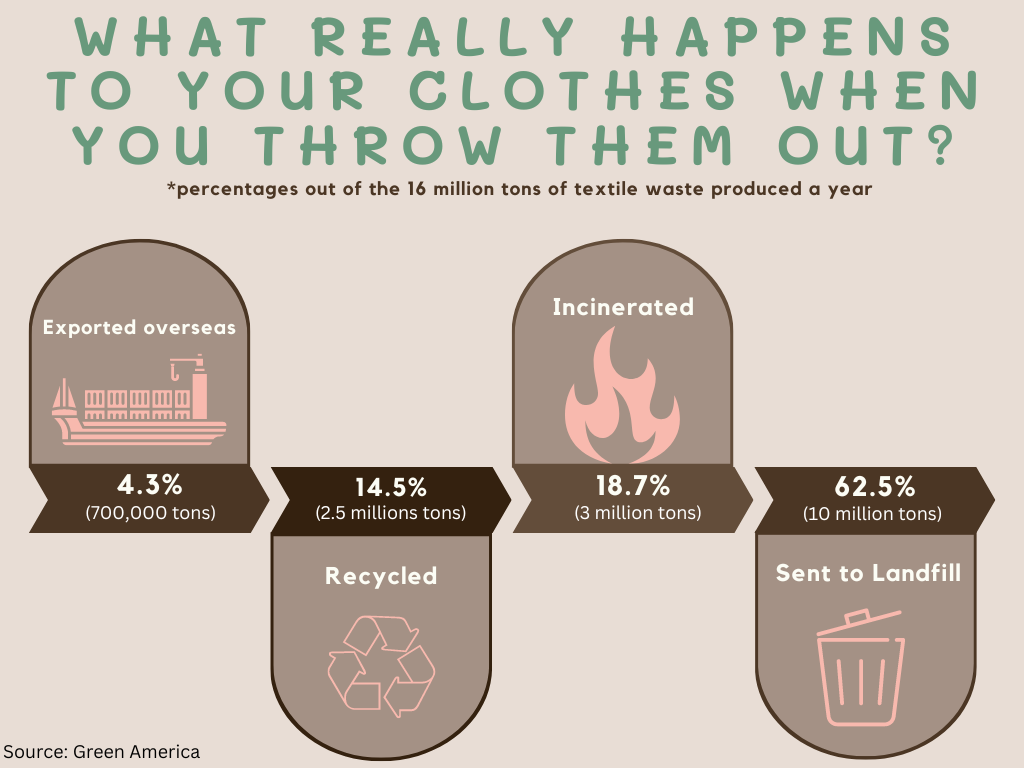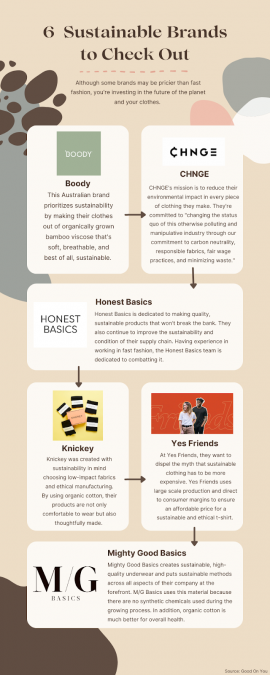Scrolling through trends: Does Gen Z really care about sustainability?
Does Gen Z really care about fashion sustainability?
Scroll through most college girls’ TikTok “For You Pages,” and ads from SheIn, Princess Polly, or H&M fill the screen. Equipped with discount codes and promises of the latest trends, Gen Zers are eager to buy.
Katie Hill, like many Gen Zers, considers herself a fashionable person and wants to keep up with the latest trends. She even posts outfit of the day TikToks to show her followers the trendy pieces she’s wearing. Hill isn’t the only TikToker showing off her outfits. Click the #OOTD tag, and you’ll find thousands upon thousands of girls showing off their outfits. But how can girls possibly keep up with this many trends? Fast fashion.
“I am definitely all about convenience and price,” Hill said. “I would like to say that I really want to be environmentally friendly, but I find I don’t always prioritize that.”
Gen Z has been coined the “generation of sustainability” and cited as the generation that has brought considerable attention to sustainability. Good Maker Tales reports that more than half of Gen Z surveyed will pay 10% more for a sustainable product. 70% claimed that sustainability is an important factor in their buying choices. But does Gen Z really do what they say? The article later reports that a 2020 study found that more than half of Gen Zers surveyed still buy from fast fashion companies.
Engaging in fast fashion isn’t anything new. According to Forbes, one in three Gen Zers feel as if they’re addicted to fast fashion. Social media perpetuates the circulation of trends — and subsequently, fast fashion brands — and encourages buyers to prioritize cheapness and convenience over quality. Fast Company reports that around ⅔ of company leaders have admitted to greenwashing. If sustainable companies don’t disrupt the market, Gen Zers may continue to buy from fast fashion brands.

Princess Polly has it all: trendy pieces, affordable prices, and fast shipping. Like other college girls, Isha Goel has made Princess Polly one of her go-to places to shop. Goel, a senior at Tulane University, applied to Princess Polly’s ambassador program (Princess Polly on Campus Program) on a whim. She wanted to do something with her summer and ended up sending in her application this past May. Since she loves their pieces, she thought why not.
“As a college senior in Greek life, events sometimes happen on the spur of the moment, and I don’t always have time to look for more sustainable options,” Goel said. “Having an option like Princess Polly helps save you time, and you’ll definitely find something you want.”
Sustainability in clothing hasn’t always been a major concern for her. When shopping for a new date night dress this semester, however, one piece caught her eye. The draw? The ‘low impact’ sticker. Princess Polly’s website says it wants 60% of its range to be sustainable by 2025 and is already making elements of its line out of sustainable materials. She says that before seeing it, she wasn’t really aware of sustainable options other than Goodwill or Plato’s Closet, two popular thrift stores. However, she wants to learn more about sustainable fashion because college students make up such a large portion of the fast fashion market.
“If enough college kids knew about the importance of sustainable fashion and actually contacted these brands, I think change could happen,” Goel said. “Although Princess Polly is doing the minimal amount in terms of sustainability, I feel like companies like this would listen and shift their products if there was more of a push.”
Despite the statistics, not all Gen Zers are aware of how wasteful the fashion industry is. It wasn’t until sophomore year that Maddie Lindsay, a senior Fashion Design major, learned the fashion industry was the number one contributor to climate change. Now, she’s learning how to reduce fabric waste by experimenting with reusing fabric scraps and cutting her fabric a certain way to limit her waste. She also notes that Syracuse’s fashion design program has prioritized sustainability within making clothes to be prepared for the future and hopefully change the design process. Lindsay says that the program is also implementing fabric bins to put your scraps in to encourage reusing and recycling.
While Gen Z designers are learning more about how to ethically make clothes, the reality is that not all of us are going to learn to sew or make our own clothes; most of us probably don’t want to when there are cheap and convenient options readily available. But these face-value benefits come with a price. Can college consumers steer themselves away from these fast fashion brands? Lindsay says it’s going to take large corporations to make changes from top to bottom to help influence consumers. One college student not buying from a fast fashion company won’t make the impactful change that’s needed, she says.
Lindsay suggests that instead of producing garments that only a handful of people may want, take that money and put it towards dying fabric (which is much cheaper) or put this money towards better conditions for their workers. Instead of justifying dropping $600 dollars at Shein because you believe you can’t afford a few quality pieces from Reformation, find a good balance between shopping small and finding places that produce clothes ethically or dabble in upcycling.
“My advice would be to do your research in the companies that you’re buying clothes from and take the time to look into them instead of shopping on Shein,” Lindsay said. “There are plenty of companies out there that are now making sustainable efforts, you just have to find them.”

Kara Swan, a Public Policy and Global Health student at the University of Iowa, seeks transparency from brands and prioritizes researching brands that practice sustainability. She says that you can’t try to find staples for your closet with the production and modality of fast fashion markets. When she shops, she usually looks at places like Plato’s Closet or ASOS.
Thrifting has increasingly become popularized and places like Plato’s Closet and GoodWill are main targets for Gen Z shoppers like Swan. Online thrift store brands like ThredUp and Depop are also attracting Gen Z’s attention. Seeking out sustainable brands may be easier said than done because, after all, fashion companies are running a business at the end of the day. However, this doesn’t mean that businesses can’t transform themselves and create a new mindset — one with sustainability in mind.
“Companies should begin with the end in mind and factor sustainability into that framework,” says Mark Coleman, a Whitman professor and author of three books.
Working closely with companies in the business of sustainability, he knows the difficulty of living in a generation of consumerism and keeping up with trending products. He notes that our society has been led down a path where we feel we need to buy the next big thing instead of prioritizing the quality of products.
Coleman says that there are opportunities for fashion companies to implement sustainability and encourage the practice of making sustainable choices in everyday life, starting with where you buy clothes. Businesses should be deliberate with their sustainable initiatives and prioritize giving consumers quality products. For example, companies could disclose that their fabrics are ethically sourced and disclose where it’s sourced or address labor issues head-on. More and more, consumers are looking to find quality products that are produced ethically and see the company’s values in their clothing.
Coleman says that there are certainly opportunities for new entrepreneurial endeavors that will keep sustainability in mind and disrupt the fashion market. Instead of companies having to make sudden shifts, founding a company with sustainability in the framework will adhere to Gen Z’s needs. Despite the opportunities, start-up companies have an especially challenging role since they introduce a new product and business, but also have to maintain success and keep their new business afloat. On the other hand, these start-ups have a unique opportunity to build sustainable practices into the framework of their companies instead of having to play catch-up.
Major fast fashion brands like H&M or Shein will continue to struggle and implement sustainability into their company so late in the game. The company wasn’t founded with sustainability in mind and the quick, unethical production of clothing clearly does not jive with wanting to be “sustainable.” Coleman suggests brands possibly streamline a collection and work with specific materials and dyes. It’s ultimately up to brands to hear their consumers and execute these wants.
Advertising plays a huge role in not only promoting products but impacting the circulation of clothing companies. Social media is a hub for ads that specifically target Gen Z. Platforms like TikTok and Instagram popularize trending sounds, dances, and clothes, and dictates what Gen Z deems “cool.” Behind every strategically placed ad is a smart advertising agency. Based in LA, NinetyEight is a digital marketing agency that specializes in targeting Gen Z. Created by a team of Gen Zers, they get it. NinetyEight — all born in 1998 — also understands how companies advertise to an audience, especially an audience that’s accustomed to fast-paced ads and content. CEO Celine Chai says marketing people don’t get it, and there aren’t enough Gen Zers within these positions.
View this post on Instagram
“When it comes to fashion, the industry is somehow an exception to sustainability,” Chai said. “We definitely don’t all have the means to shop completely sustainably.”
However, Chai says that at the end of the day, Gen Z is still a generation that cares and wants to work with what they have and implement sustainability in other ways. She believes that at some point, we will be able to say no to fast fashion but isn’t sure when that point will come. Rachael Previti, a social media strategist at NinetyEight, believes that advertising is taking an idea or brand and making it desirable. This desirability especially applies to Gen Z’s desire of following trend culture. Like many Gen Zers, Previti believes that making sustainable changes on an individual level isn’t going to make much of an impact, despite being aware of the climate crisis. Previti also says that it’s up to the big corporations to make drastic changes to make the most impact.
Influencer marketing also plays a major role in the circulation of trends, she says. Getting the most use out of your clothes and resisting trends is easier said than done but, it’s important to realize that trends are trends; they won’t last forever. Finding a balance between following trends and making use of what’s already in your closet could be crucial to resisting trend culture and the draw of fast fashion.
Niche communities, like the many sides of TikTok, could be huge for brands. Previti says brands have a unique opportunity where they don’t have to appeal to the general public, and you can build an aesthetic around sustainable clothing and break through the For You Pages of others. If you can build an aesthetic around sustainable fashion and make it something that people really want, you could really make a difference, Previti says.
Although fast fashion isn’t going away anytime soon, there are things that we can do to combat it. “Because advertising plays such a huge role in fast fashion, I would recommend that brands attempt to make sustainable fashion an aesthetic and find a few influencers to promote it to really make it something that people want,” Previti said. All it takes is a trending tag and sustainable fashion could be the next big trend.





